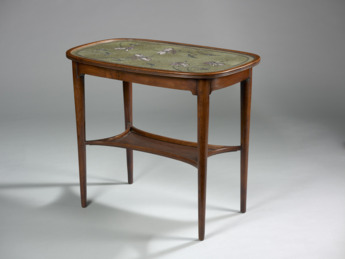Oval Table with Beadwork Top
Possibly Vienna, Circa 1900
Of irises on a variegated green ground, the frame of stained beech with bentwood rim and beech plywood stretcher. Circa 1900.
Height 28½" (72.5cm).
Width 33¼" (84.5cm).
Depth 21¼" (54cm).
This technique of beadwork under glass is known as 'Cloisonné Glass' and was patented in London in 1897 by Theophil Pfister and Emil Barthels.(1) The Cloisonné Glass Company (presumably owned by Pfister and Barthels) of 40 Berners Street /Oxford Street, manufactured screens, windows, furniture and smaller items at the turn of century and was still in production in 1905, when they published a trade catalogue which describes the technique in great detail.(2) See also Dr. Sebastian Strobl's paper entitled, 'Painting with Beads - The work of the London Cloisonné Glass Company', for a description of the technique.(3)
Little is known about the artists who used this technique to produce all types of objects, ranging from small paperweights to large architectural panels, but one has been identified. In 1898, a young Catalan, Frederic Vidal Puig (1882-1950), travelled to London from Barcelona to learn the process, returning to Spain the following year, where he produced a large body of work, including windows, until his departure for Argentina in 1904.(4) However, licences were sold to other countries in Europe and the United States from the early-20th Century.(5) With this present table, the oval bentwood beech frame holding the glass panel relates to Austrian tables of the Art Nouveau period, and the iris is a recurring theme in the work of Otto Eckmann (1865-1902), but these are not enough to allow a firm identification of the maker. Despite the mystery of its nationality and its designer, this table remains an important and rare example of 'cloisonné glass'.
______________________________
Footnotes
1. Victoria Government Gazette for Oct 15, 1897: Patents No 14561 by Theophil Pfister of 65 Holborne Viaduct London, manufacturer, and Emil Barthels of Mattapoisette, Bedford Park, London, merchant, for 'Improvement of cloisonne work.'Patent Office, Lonsdale St. west, Melbourne E de Verdon, Commissioner for Patents.
2. National Art Library, Cloisonné Glass Company Catalogue, London, 1905 (Pressmark 89.M, Box 1).
3. Forum for the Conservation and Restoration of Stained Glass. Techniques of Stained Glass in the Nineteenth Century in Namur, Belgium, June, 2007. (We are grateful to Jutta Page, Curator of Glass & Decorative Arts at The Toledo Museum of Art, for this reference).
4. National Art Library, Manuel Garcia Martin, Introduction to Exhibition of the Cloisonne glass work of Frederico Vidal, Barcelona, Museu d’Arte Modern, 1985.(Pressmark 506.D.44). Also, Jordi Bonet, ‘Conservation–restoration of cloisonné windows: A case study’, in Science Direct - Journal of Cultural Heritage, Vol. 9, Supplement 1, December 2008, pp. 69-72.
5. Ibid.







